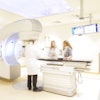
New brachytherapy products have been introduced recently that allow accelerated radiation treatment for cancer patients after surgery with excellent results, increased comfort, and fewer side effects than traditional external-beam radiation.
Several large-scale clinical trials have proved the effectiveness of these devices compared with traditional therapy, encouraging more patients to opt for the accelerated approach. This has stimulated investment in the technology, expanding the available options for both physicians and patients. As confidence in the technology has grown, the referral base has increased, creating a good opportunity for future growth.
A growing market
Total U.S. brachytherapy sales increased about 8% per year between 2006 and 2008. However, this should change after 2008, with compound growth in the range of 30% per year from 2008 to 2013 as new products enter the mainstream. Therefore, sales of $239.7 million in 2008 should grow to $1.265 billion by 2013, with further increases to $1.979 billion by 2016.
There are six major brachytherapy categories: implantable prostate seeds, accelerated partial-breast irradiation, gynecological brachytherapy, irradiated microspheres for liver cancer, ophthalmic applications for intraocular tumors, and a large emerging market for treating macular degeneration, where the incidence and prevalence of disease is very high.
There are also various products for interstitial brachytherapy and specialized applications such as brain cancer, esophageal cancer, colorectal cancer, head and neck cancer, and skin cancer. However, these are smaller components with products that are often improvised for specific applications.
Forecast of sales (in millions) of brachytherapy products by product group, 2009-2016
|
Changes in product emphasis
Implantable prostate seeds were introduced in the mid-1990s and have proved effective with a large number of patients. Approximately 25% of all newly diagnosed cases of prostate cancer are treated with implantable seeds, and this level should remain steady even though more treatment options are being offered.
Because the market for prostate seeds is mature, only the most resilient companies have survived, and there hasn't been much investment in new technology. One exception is the introduction of cesium seeds by IsoRay Medical of Richland, WA. These seeds are more expensive than iodine or palladium, but they offer higher levels of radiation over a shorter half-life. Some clinicians feel that this gets closer to achieving high-dose radiation (HDR) treatment with a low-dose radiation (LDR) product. This same principle is utilized to sell palladium seeds over iodine, as palladium has higher energy and a shorter half‑life than iodine.
Competing technologies
Several competing radiation therapy technologies have been introduced recently that have affected the market for prostate seeds. One is intensity-modulated radiation therapy (IMRT) coupled with image-guided radiation therapy (IGRT). These modalities are being utilized in conjunction with prostatectomy to improve patient outcomes, and they are also used on a stand-alone basis in certain cases in lieu of prostate seed implants.
Proton therapy is another option that has become more widely available as an alternative to prostate seeds implants. This therapeutic modality offers greater precision in focusing radiation on the prostate, with fewer negative side effects compared with traditional external-beam radiation. However, it is considerably more expensive.
Another modality that has affected prostate seed implants is robotic microsurgery for prostatectomy, particularly the da Vinci surgical system produced by Intuitive Surgical of Sunnyvale, CA. This system provides greater precision in surgically removing the prostate than traditional surgery, with fewer negative side effects. However, considerable training is required to become proficient with the system.
Accelerated partial-breast irradiation
Accelerated partial-breast irradiation (APBI) was first introduced on a practical scale in 2002 with the approval of MammoSite from Proxima Therapeutics. Proxima had a good response to MammoSite and the company was acquired by Cytyc in 2004. Cytyc, in turn, was later acquired by Hologic of Bedford, MA, in 2007.
MammoSite was a breakthrough in brachytherapy because it is easily inserted into the resection cavity after lumpectomy, applying radiation locally over a short range with good precision. There have been several large multicenter studies with MammoSite demonstrating effectiveness equal to external-beam radiation.
The success of partial-breast irradiation has spawned the development of several new devices that offer advantages with a wider range of patients. Three of these devices have received U.S. Food and Drug Administration (FDA) approval and two of them have already entered the market. SAVI (developed by Cianna Medical of Aliso Viejo, CA) was introduced in 2006 and Axxent (developed by Xoft of Sunnyvale, CA) was introduced in 2008. The third device, ClearPath (developed by North American Scientific of Chatsworth, CA), recently received approval.
New breast brachytherapy devices
Cianna's SAVI device employs multiple parallel tubes, which act as struts around a longitudinal core. The core can be retracted in a controlled fashion, forcing the struts outward to expand in the resection cavity. The acronym SAVI (strut-altering variable-irradiation device) is descriptive of the mechanism. An irradiated wire (iridium-192) is passed through the individual struts progressively in a timed sequence, which distributes the radiation in the resection cavity. This provides more accurate control of the radiation than MammoSite and reduces the risk of overexposure in critical areas.
North American Scientific's ClearPath device is somewhat similar to SAVI, but it has two rows of longitudinal tubes. The outer row of tubes or struts expands outward to shape the resection cavity when the core is retracted. However, the inner row of tubes is used to conduct the radiation source. This allows somewhat more separation of the radiation source from the skin. However, it hasn't been demonstrated that this offers a real advantage.
The ClearPath device also allows the use of palladium seeds, which can be inserted in the inner row of tubes for low-dose therapy. This allows more freedom for the patient because an afterloader and vault room are not required to deliver the radiation.
Xoft's Axxent device is a departure from traditional HDR therapy in that it utilizes a miniaturized x-ray source that is integrated with a catheter. This was originally designed for endovascular brachytherapy but was redirected when the market shifted to drug-eluting stents.
Axxent has combined its miniaturized x-ray source with a balloon that is inflated in the resection cavity, somewhat like MammoSite. Xoft supplies a controller that positions the x-ray source in the balloon and applies the necessary voltage to generate the x-ray beam in the resection cavity.
Axxent has several advantages over traditional HDR brachytherapy in that it does not require a shielded vault room with afterloader to handle the radiation source. This allows more flexibility because minimal shielding is required. In addition, this technology has permitted Xoft to design a mobile version of its system in a coach that can be moved from one location to another, providing another measure of flexibility.
Gynecological applications
The success of partial-breast irradiation has led to the development of similar devices to treat cervical and uterine cancer. These devices are inserted into the vagina and apply radiation locally to the affected area. One version is an adaptation of the Axxent device that utilizes a specialized adapter for the miniaturized x-ray source to direct the radiation intravaginally.
Another device that recently received FDA approval is Gynocyte, developed by Bio-Nucleonics of Doral, FL. This uses cesium-137 in an LDR low-dose configuration. The current version employs sealed cesium sources (seeds) that are introduced to the device. Bio-Nucleonics is currently working on a second-generation device utilizing cesium-132, which has a seven-day half-life that will allow simpler handling and disposability.
Endovascular brachytherapy
Endovascular brachytherapy was pioneered by Novoste and successfully introduced in 2001. The market grew quickly and reached almost $100 million in 2002, with Novoste in a dominant position. There was a compelling need to reduce the rate of restenosis with bare metal intravascular stents, and endovascular brachytherapy was very effective. When drug-eluting stents were introduced in 2003, it decimated the market for endovascular brachytherapy because drug-eluting stents were easier to use and were favored by cardiologists.
In 2004, Novoste sold its business to Best Medical of Springfield, VA, which continued to operate Novoste as a subsidiary supplying Beta-Cath devices, primarily for treating in-stent restenosis. A certain proportion of drug-eluting stents still fail in this mode, and endovascular brachytherapy is effective in limiting tissue proliferation after the stenosis is cleared.
Recently, there has been a resurgence of interest in endovascular brachytherapy because of late clotting events with some drug-eluting stents after two years or longer. This requires removal of the blockage and irradiation of the endovascular surface to limit further tissue proliferation. Therefore, this market is growing slowly as a result of the continuing need to deal with in‑sent restenosis.
Irradiated microspheres for liver cancer
Another brachytherapy application that has grown steadily is direct infusion of irradiated microspheres to treat liver cancer. Many liver cancers occur secondary to other primary cancers including colorectal cancer, lung cancer, and breast cancer that metastasize to the liver.
There are two companies producing irradiated microspheres: Sirtex Medical and MDS Nordion of Ottawa, Ontario. Both have made significant progress in developing effective protocols for administering the microspheres and training interventional radiologists in the required methodology.
Sirtex, an Australian company and pioneer in the field, entered the U.S. market in 2002. As demand for its SIR-Spheres has grown, management decided to begin producing its product in the U.S. for distribution in the U.S. and Canada. Prior to 2008, its entire product output was produced and shipped from the company's home base in Australia.
Nordion's product, TheraSphere, was acquired from Theragenics in the late 1990s, and demand has steadily increased. Its market base is smaller than Sirtex; however, both products have been successful, with recent sales growth in the range of 25% per year.
Sirtex utilizes plastic microspheres, whereas Nordion utilizes glass microspheres. Both are coated with yttrium-90, which emits beta energy over a short range. Therefore, the microspheres can be injected intra-arterially in close proximity to the tumors being treated. Because the half-life of yttrium‑90 is 68 hours, there is little residual energy emitted after a few days.
Most patients who are candidates for this procedure have already been through various courses of chemotherapy and have limited endurance. Therefore, an alternative therapy is offered, which provides a respite of sorts from other treatment, where the microsphere procedure can be implemented. The medical oncologist still controls the patient; however, there is a temporary hiatus, where the other physicians can perform the treatment planning and microsphere infusion. This cooperative approach has been very successful and maintains continuity for the patient with the medical oncologist.
These products are priced considerably higher than other brachytherapy products at $14,000 per dose. However, the market treats this more like a therapeutic radiopharmaceutical than other brachytherapy products. The sophistication of the product and the skill and teamwork required of the different clinicians justify the high price.
Macular degeneration and ophthalmic applications
Brachytherapy has been used for some time in ophthalmic applications for treating intraocular tumors, including choroidal and uveal melanoma. However, recently there has been a new development in ophthalmic brachytherapy for treating age-related macular degeneration.
The incidence of macular degeneration in the U.S. is 220,000 cases per year, and the prevalence of existing cases is greater than 2 million. Worldwide, the numbers are much higher. In this disease, blood vessels proliferate in the retina, causing blood and fluid to be released into the eye, destroying retinal function.
There has been progress in treating this disease with a new class of drugs that inhibit vascular growth, called vascular endothelial growth factor (VEGF) agents. Avastin, a VEGF inhibitor originally developed by Genentech of South San Francisco for treating colorectal cancer, is the first FDA-approved therapy designed to inhibit angiogenesis, the process by which new blood vessels develop.
Retinal specialists discovered that this mechanism for inhibiting new cancer growth could be applied to limiting new vascular growth associated with macular degeneration. Genentech obtained approval for a dedicated version of Avastin for ophthalmic applications and labeled it Lucentis. Macular degeneration is similar in some respects to new tumor growth: It involves neovascularization and a compromised vascular network in the body. Both require the same type of stimulus for growth.
The vessels in the back of the eye become diseased through the normal repopulation of the retinal cellular structure, and the diseased cells repopulate more quickly than normal, enabling this new vascular growth to occur. The benefit of Lucentis is that it stops the leaking and creates a barrier. It does not treat the underlying cause, however, and once the drug fully leaves the eye, the growth starts again. As a result, injections are required once a month to maintain the desired effect.
Brachytherapy and VEGF drugs
NeoVista of Fremont, CA, has developed a brachytherapy system called Vidion to augment the effect of Lucentis and limit macular degeneration. The system utilizes both radiation and Lucentis to treat the disease. The brachytherapy procedure is performed initially, and then Lucentis is injected into the back of the eye. In the process, vision is restored to predisease levels with fewer injections. The brachytherapy procedure is performed once and the therapeutic effect eliminates the need for monthly intraocular injections.
This helps patients because it reduces the need for continuous injections, which are discomforting and expensive. Physicians also are receptive because they do not have to keep reminding patients to maintain the injection schedule. Furthermore, government payors are supportive because of the cost savings in medication.
Features of the NeoVista device
NeoVista's Vidion incorporates a controller that deploys a strontium-90 wire source through a drive train and guide that is inserted into the eye through the sclera from the side. The source is positioned above the retina, where the radiation can be directly applied to seal the leaky blood vessels. The control unit calibrates the source and maintains control over the movement of the strontium wire during the procedure. The delivery device is disposable and the control unit is reusable. Commercialization of this device in the U.S. is planned for 2010; NeoVista currently has CE Mark approval in Europe.
The lease cost for the delivery module will be approximately $1,000 a month, which is fairly modest for this type of setup and is less costly than other controllers used in brachytherapy. The disposable part of Vidion is the surgical pack used for each procedure. This will be priced at about $3,000, and the company's primary revenue will be derived from these surgical packs.
NeoVista estimates its market potential at 40% of the 220,000 newly diagnosed cases of macular degeneration annually in the U.S. In addition, sales will be augmented from the prevalent population of existing cases.
Future prospects
Other new applications for brachytherapy will undoubtedly emerge during the next several years as physicians become more creative in utilizing these modalities. This should stimulate further investment in the field, as the return on investment can be substantial. One advantage is that FDA clearance is based on the 510(k) application, which is considerably easier to implement than drug-related applications. Although competitive products may also be introduced with less rigorous clinical trials, it still provides good incentives for entrepreneurs with good technology.
By Marvin Burns
AuntMinnie.com contributing writer
April 23, 2009
Burns is president of Bio-Tech Systems, a Las Vegas-based healthcare market research company founded in 1980. The firm specializes in medical imaging and radioisotope products covering a broad range of diagnostic and therapeutic applications for strategic planning, market research, and development of new business opportunities. For further details and information, Bio-Tech Systems can be reached at 702-456-7608 or via its Web site, www.biotechsystems.com.
Bibliography
Bio-Tech Report 290: U.S. Market for Brachytherapy Products, April 1, 2009
Bio-Tech Report 280: Market for PET Radiopharmaceuticals and PET Imaging, July 10, 2008
Bio-Tech Report 270: U.S. Market for Diagnostic Radiopharmaceuticals, November 15, 2007
Bio-Tech Report 260: US Market for Medical Imaging Contrast Media, February 18, 2007
Bio-Tech Report 230: World Market for Therapeutic Radiopharmaceuticals, February 10, 2006
Related Reading
Effectiveness of APBI breast cancer treatment is age-neutral, study suggests, April 20, 2009
Single-entry APBI offers flexibility in treating breast cancer, April 3, 2009
High-dose brachytherapy shortens cancer treatment, March 30, 2009
Study: APBI compares favorably to standard RT, October 1, 2008
Copyright © 2009 Bio-Tech Systems



















